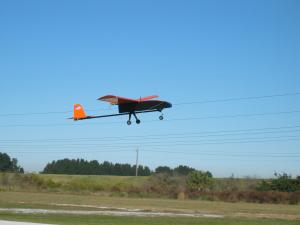
There is not enough room here for me to go into what I would like to tell you, so I will just start with how I developed the first digital spread spectrum RC system. It was back in 2001, and I was in the small UAV business building autopilots and telemetry systems for small UAVs.
I was looking into conducting a flight of a 10 ft UAV to an altitude of 30,000 ft. After giving this task a great deal of thought, one of my biggest concerns was how to ensure that I would have reliable control of the aircraft. I had planned to fly most of the flight under autonomous control, but I still wanted to have the ability to take over manually or make changes in the flight profile should the need arise.
I came to the early conclusion that hobby-type radio control systems did not have sufficient protection against intentional or unintentional interference. My concern was that while the aircraft was at altitude, it could be subject to higher levels of natural or man-made radio frequency interference, and without some form of protection, it would be very easy to lose control of the aircraft with devastating results. The biggest concern that I had was if, unknown to me, a 2nd 72 MHz hobby R/C transmitter was transmitting on the same frequency that I would be using to control my aircraft, and if the operator of that 2nd transmitter flipped the same switch (CH5) on his transmitter that I was using on my transmitter to activate the autopilot, I may not be able to override his input and could lose control of the aircraft.
I reviewed the technology that was available and decided to use Digital Spread Spectrum. I then started developing what is now the Grand Daddy of all of the Digital Spread Spectrum Radio Control Systems that are being produced and sold to the RC hobbyist the world over.
What I developed was truly a unique system that has many levels of protection from interference. During the testing phase of the system development, I designed and built a solid-state A/B switching system that could be used to transfer control of the test aircraft from the experimental digital Spread Spectrum radio control system over to a 72 MHz system. I did this in case of component failure in the digital spread spectrum radio. This was a safety issue as well as a financial one, as I did not want to endanger anyone on the ground and I couldn't afford to lose the test aircraft with all of the equipment onboard. Attached is a photo of Fred Marks of FMA test flying one of AUAV 's DSS Digital Spread Spectrum Radio Control System in November 2003.
In another photo, you can see the first version was a cobbled-together proof-of-concept version. It worked so well that I decided to build a 2nd version. Version 2 was built using a Plastic Radio Shack project box and control sticks from an old Futaba G series transmitter. Version 3 was built using transmitter cases and control sticks from Silvertone Electronics Sydney, Australia, and became our production version. Version 4 was a Frequency Redundant Digital Spread Spectrum R/C Control.
If you are interested in knowing more, please feel free to call or text me at 1-941-723-9058 or email me at dave@auav.net.
Thank you,
Dave Jones


